Join 100,000+ Drivers
- Sponsorship
- Thinking of Becoming a Truck Driver?
- Getting a CDL License
- Trucking Driving Jobs Guide
- Trucking Company Guide
- Trucker Life
- Paid CDL Training
- CDL Schools
- Professional Driving Skills + Knowledge
- Owner Operator
- Latest Articles
- Truck Driver Skills

The Pre-Trip Inspection: A Practical Guide For the Truck Driver
Updated February 24th, 2022
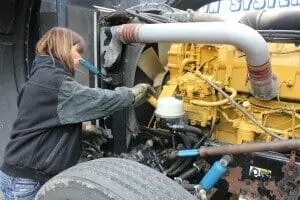
The pre-trip inspection is an integral part of every road trip for a trucker.
It’s probably the most disliked and most often overlooked part of the job of the professional truck driver in the trucking industry.
This inspection is meant to be a thorough check of the truck, trailer and load.
The check is to ensure that everything is in correct working order, prior to the truck and driver, departing on a trip.
Any damage or issues found during the pre-trip inspection which needs attention, must be addressed before departure.
CDL Test Pre-Trip Inspection
If you just came through the process of getting your CDL, you can breathe a sigh of relief.
You don’t have to check all 500 or so items that you had to memorize for the test every single day.
Out on the road, a thorough pre trip shouldn’t take more than 10 to 15 minutes.
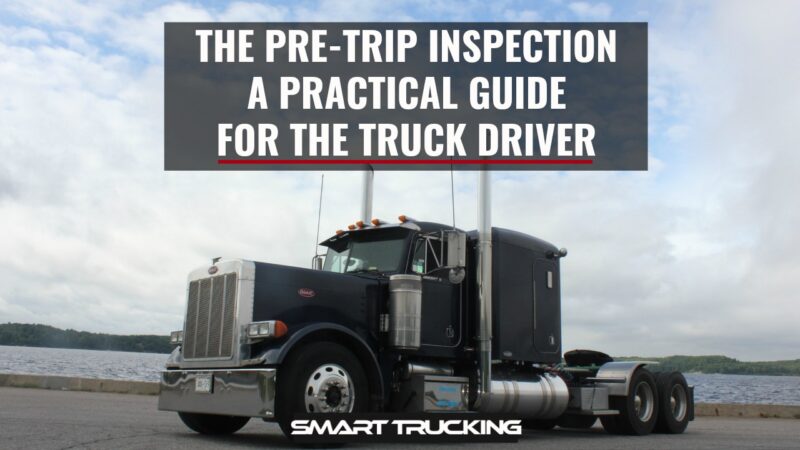
DVIRs – Daily Vehicle Inspection Report
According to federal law ( FMCSR Section 396.11 ), every day, a driver must submit a Daily Vehicle Inspection Report (DVIR) for each power unit he operates. Multiple trailers can go in one report.
DVIRs are either paper or electronic.
Not every trucking company (ahem) enforces this policy, so some truck drivers can go months or years without submitting a DVIR.
Minimum DOT Pre-Trip Inspection Requirements
- Service brakes including trailer brake connections
- Parking brake
- Steering mechanism
- Lighting devices and reflectors
- Windshield wipers
- Rear vision mirrors
- Coupling devices
- Wheels and rims
- Emergency equipment
Your trucking company’s DVIR might be more thorough.
This is a thorough Q&A on DVIRs which you can refer to.
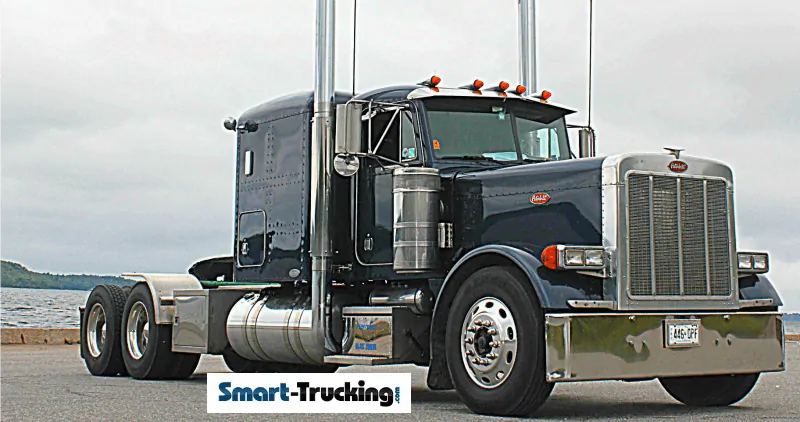
Inspecting a New Truck
When you are assigned a new truck (either daily or just once), there are a few additional things you need to check for on the pre-trip inspection.
Truck Compliance
- Cab card and book – This is a book containing the registration, inspection, permits, cab cards, IFTA paperwork, and any other important papers for the truck. Make sure it is in the truck and all the paperwork is up to date.
- Inspection sticker – This is outside the truck. Find it and make sure the truck is not overdue.
- IFTA stickers – These are the fuel tax compliance stickers. They are on both sides of the truck. Make sure the current year is displayed.
- Elog device – Most trucks are required to have a working elog device.
- Required permits – These are in the cab card book. The most common permits are Heavy Motor Vehicle Trip Permit (Oregon) and the Weight Distance Tax Permit (New Mexico).
- New York HUT sticker – This is usually on the front of your truck. It’s a type of permit.
- License plate – Make sure the license plates on the front and back of the truck match.
- FMCSA Safety Regulations and Hazardous Materials book – These will be given to you by your company. They must stay in your truck within arms reach from the driver’s seat.
- Paper logbook – If your e-log stops working, you must log your hours in a paper logbook, which must be kept in your truck.
- Medical card – You must keep your current medical card in your truck. Always have your CDL on you as well.
- Orange triangles – You must have 3 triangles for when you break down.
- Fire extinguisher – Must be charged and secured to the truck. No rolling around on the floor.
- Extra fuses – If your truck doesn’t use circuit breakers, you must have spare fuses.
- Load bars and/or straps
- Extra oil, coolant, and windshield washer fluid
- Line antifreeze and diesel anti-gel
- Chains and bungees
- Gladhand seals
- Hammer, wrench, wire cutters, cable cutters, knife with glass-breaker
The Class A Pre-Trip Inspection Process
Unless I have to bobtail to pick up my trailer, I inspect my truck and trailer together.
The best way to memorize a thorough pre trip is to do it the same way each time.
Your process will look different from mine, but as long as you are consistent, you will be less likely to miss anything.
I do the inspection first thing each morning as well as every time I swap trailers.
Paperwork and Trailer
- Check the paperwork. It should be the first thing checked when you get to your truck.
- Match the trailer number to your paperwork. If your trailer has a seal, make sure it matches too.
- Unsealed trailer. If your trailer does not have a seal, open it and confirm the product matches the bills. If you are picking up an empty trailer, open it and make sure it’s actually empty.
- Confirm your destination. Ensure the destination is the same as on your trip sheet or load assignment. If there is a discrepancy, call your dispatcher.
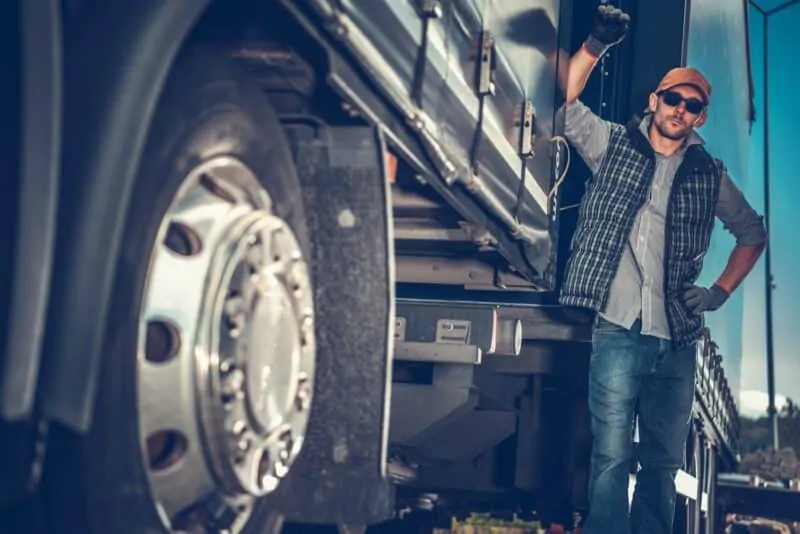
I personally like to start with checking under the hood of the rig. Not everyone does, but I do.
Under the Hood of the Truck
I walk around the front of the truck, making sure all the lights work. Then I open the hood.
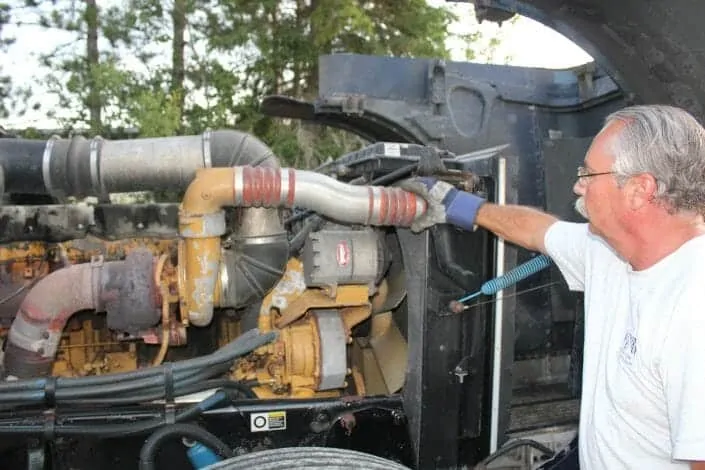
- Fluid levels – Check all fluids: coolant, oil, power steering fluid, and windshield washer fluid. Make sure caps are tight for the rad, oil filler, power steering fluid and the dip-stick is seated properly.
- Alternator, water pump, power steering pump –Make sure these are in good working order, and the belts are not worn or have too much slack.
- Observe at the engine block. Check for leaks, fluid running down the side of the engine. Check for wear, cracking or fraying. Inspect fan belts for proper tension and signs of wear.
- Hoses – Check all hoses for leaks, cracks, and tears.
- Wiring – Check wiring for wear.
- Steering linkage – Check linkage for worn or missing parts.
- Tires – Tires should be properly inflated and have decent tread. If there are flat spots on the tire, it needs to be replaced.
- Hub seal – Make sure it’s not leaking and wiped with oil if transparent.
- Brakes – Brake chambers should not be out of round and should be free of grease. Shoes should not be worn down too much.
- Slack adjusters – Pull slack adjuster. If it travels more than an inch, it needs to be adjusted.
- Suspension – Shocks should be in good condition, and not covered in grease or oil.
Back of the Truck
Next, I check the back of my truck because it’s easier to check this before hooking to a trailer.
- Tires – Tires should be properly inflated and have decent tread. If the tires have flat spots, the tire needs to be replaced.
- Suspension – Shocks and airbags should be in good condition, and not covered in grease or oil.
- Drive shaft – Driveshaft should be undamaged and free of grease. Make sure there is no debris in the u-joints.
- Frame – The frame should not have any welds and not cracked or significantly rusted.
- Fifth wheel – The fifth wheel should be properly greased and not broken.
- Fuel tanks – Fuel tanks should not be leaking.
- Stairs and catwalk – Stairs and catwalk should be free of debris and not broken.
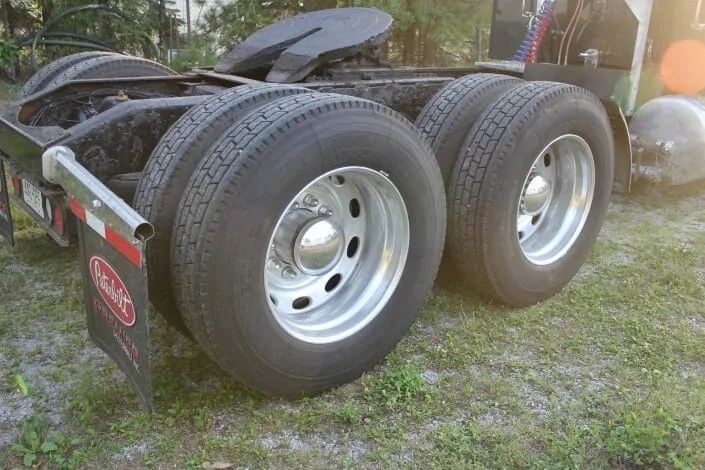
Tires should be checked with a tire gauge.
Tip . This is especially if you are slip seating. Tire thumpers aren’t very accurate. If you use a tire thumper, still check with a tire gauge from time to time.
Drives and tandems should be inflated to 100-110 psi and have a minimum tread or 2/32in. Steer tires should be inflated to 110-120 psi and have a minimum tread of 4/32in.
Tires under 50 psi should be replaced, as they can’t retain enough air pressure.
Flat spots can occur from dragging tandems in the winter or when trying to slide the tandems. Tires with flat spots should be replaced.
Check tires for damage, nails, and punctures.
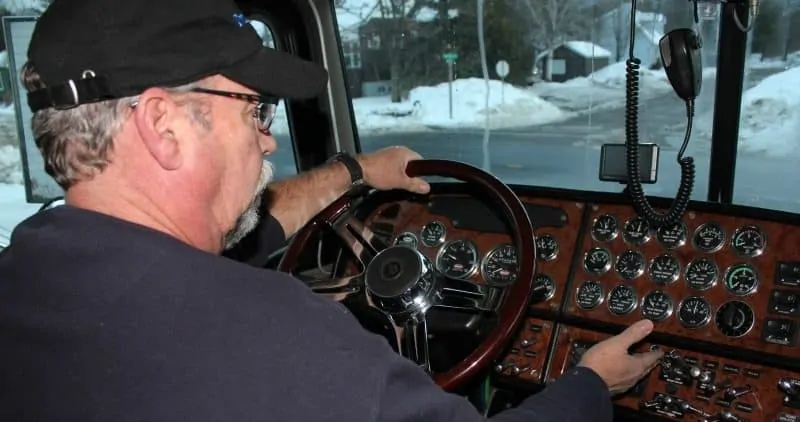
Next, I jump in my cab and start my truck.
- Gauges – Make sure air, oil, and water temperature gauges rise to normal levels.
- Mirrors – Adjust mirrors before moving your truck.
- Windshield wipers – Make sure they work and sit flat against the windshield.
- Horn – Make sure the city and air horns both work.
- Heat and A/C – Check to see if heat and/or air conditioning is working.
- Seat belt – Seat belt should not be frayed and should move freely.
Coupling and Air Lines
This is what could happen if you don’t do the tug test.
The pre-trip inspection is a pretty important thing to do.
Learn your pre-trip procedure and do it when required.

This is why you should always do a tug test when picking up a trailer. The passenger side of the front of the trailer is resting on the frame of the truck and NOT hooked up to the 5th wheel.

The front left corner of the trailer is supported by retracted landing gear only. (Not good!)
The truck driver in this photo (hopefully) learned how critical a pre-trip is. Don’t end up in a pickle like this guy.
Next, I hook up to my trailer.
- Tug test – I back under my trailer until I hear a click, and then immediately do a tug test.
A tug test tests both your coupling and your brakes. If you pull away from your trailer, you aren’t hooked properly.
If you pull your trailer with you, your trailer brakes are out of adjustment. Be absolutely sure to write it up and have it corrected before departure.
- 4 Ways + Headlights. I also turn on my four-way flashers and headlights.
- Airlines and pigtails – Next, hook up airlines and pigtails (electrical connection). Inspect to make sure they aren’t leaking or ripped.
- Visual check of Fifth wheel – Look at the fifth wheel arm under the trailer to make sure it is coupled. The arm should be in.
- Landing gear – Raise the landing gear and check for damage.
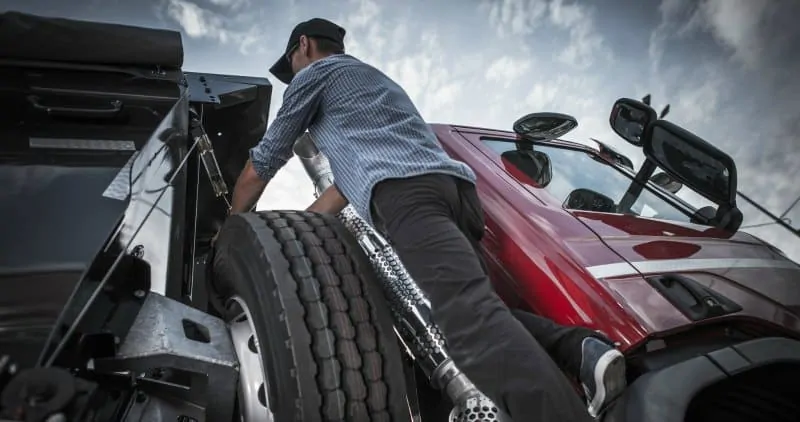
Next, I check the bulkhead (front of the trailer).
- Wall – Make sure the wall is not damaged.
- Inspection sticker – Check the DOT inspection sticker to make sure it’s not out of date.
- Registration paperwork – Check the front trailer box to make sure the registration is good.
- Reefer unit – If you are pulling a reefer, select the pre trip function on the unit and run it. It should be completed by the time you are finished your pre trip inspection.
Next step for the pre-trip inspection is to check the side of the trailer and the tandems.
- Lights – Lights should be on and flashing.
- Suspension – springs or airbags should be in good condition, and not covered in oil or grease.
- Tandem pins – Tandem pins should be locked in position, and slider arm should be in its cradle.
- Cables – Make sure the tandem cables aren’t dragging on the ground.
- Underbelly – Make sure there are no damaged beams under the trailer. Check the entire length.
- Mudflaps – Mud flaps should not be torn and hanging.
Back of Trailer
Next, I check the back of the trailer.
- Doors – Doors and hinges should not be damaged.
- Door latches – Doors should be closed and secured.
- Seal – Seal should be intact and match paperwork.
- DOT bumper – DOT bumper should not be damaged
- License plate – Check for the license plate. They tend to wear out and fall off.
Passenger Side
Next, I check the passenger side.
- Brakes – Brake chambers should not be out of round and should be free of grease.
- Suspension – Springs or airbags should be in good condition, and not covered in grease or oil.
- Mudflaps – Mud flaps should not be torn.
Ready to Roll
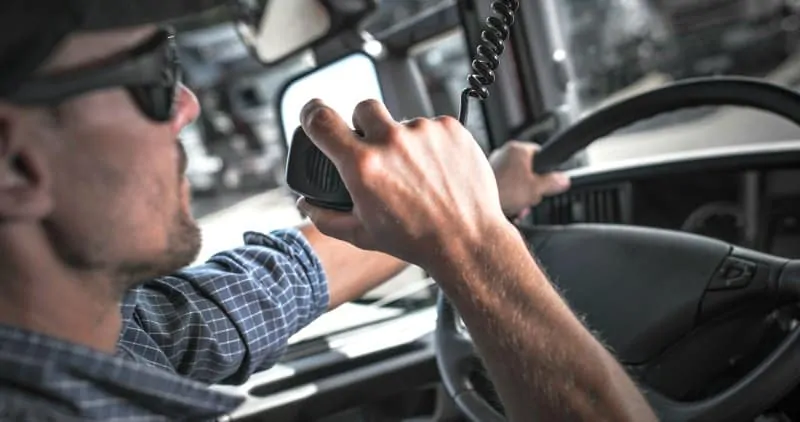
Finally, I jump in my truck and double check my paperwork and destination.
I release my air brakes, roll forward, and push the service brake.
If everything is good, I’m ready to roll.
Post-Trip Inspection
When I’m done for the day, and every time I swap trailers, I do a post-trip inspection. If I am swapping trailers, I do a pre-trip on the new trailer as well.
A post-trip includes:
- lowering the landing gear
- removing the airlines
- uncoupling, and walking around the trailer checking tires, lights, seal, and mudflaps
Then I finish my paperwork and go home.
Slip Seating
If you slip seat (meaning you are in a different truck each shift), your pre- trip check should be more thorough than if you are permanently assigned a truck.
This also applies to the first inspection after being assigned a truck.
Please be courteous and write up any problems or issues found, so the next driver of the vehicle doesn’t have to deal with it.
Side Note: Clean out your truck and throw away any trash. Common courtesy goes a long way in trucking, between drivers.
Pre-Trip Inspection F.A.Q.
Most breakdowns can be avoided with proper preventative measures, such as daily inspections.
Thorough inspections should be done at the start of each shift. Inspections of trailers should be done every time you swap trailers.
Each driver should do a thorough pre-trip every time they swap drivers.
It should take about 10-15 minutes to perform a pre trip inspection.
The DOT. Make sure you stay in compliance so you don’t end up with hefty fines and an out of service.
The best way to memorize your pre trip inspection routine, is to do it the same way every time. That way you’re less likely to miss something. If you have questions, ask your safety team at your company.
Fluids in the engine, engine hoses and wires, brakes and suspension, mudflaps, trailer registration and inspection paperwork, and license plates.
A Few Trip Planning Tips
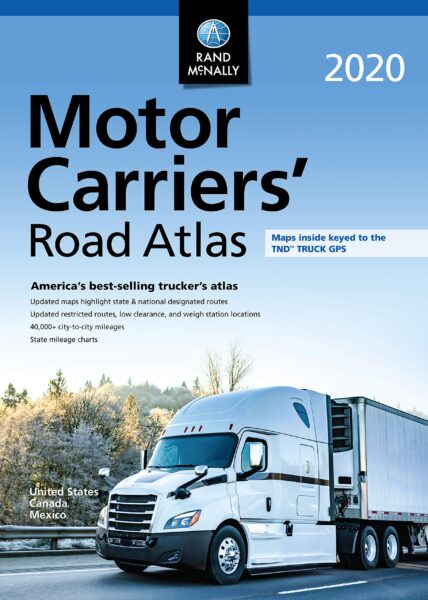
- Buy and learn to read a trucker’s atlas. It’s useful to plan routes and avoid restricted roads. I find this road atlas a necessity as a professional truck driver.
- Buy a decent trucking GPS , but don’t rely on it 100%. Use common sense.
- Don’t use the GPS in your elog device. It will put you in a lake.
Please note that minimum requirements for the inspection are established by the FMCSA.
But these may vary by state, trucking company, truck type, and trailer type.
It is your duty as a professional truck driver to perform a thorough pre-trip inspection before each trip and before you drive.
You’ll save yourself from headaches, fines and unnecessary accidents.
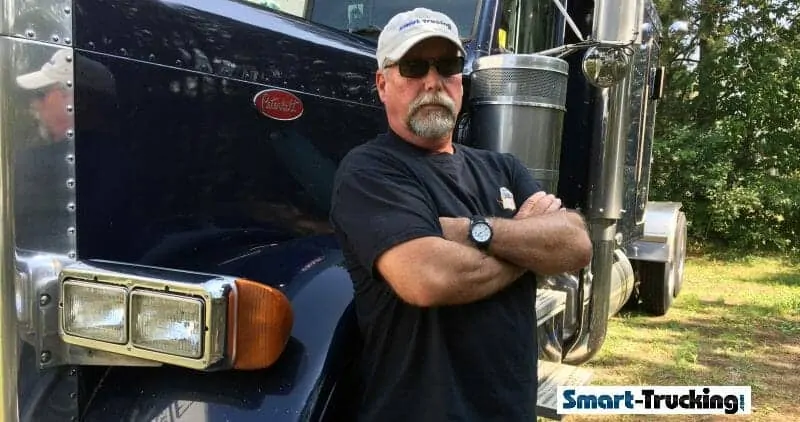
More Articles You May Like
- Trucking Terms – A Guide to Our Industry’s Lingo
- The 18 Wheeler – A Comprehensive Guide to Big Rigs
CDL Truck Driver Skills – Tips, Tricks + Knowledge to Kick Your CDL Skills Up a Notch!
- The D.O.T. Physical- A Guide For the Truck Driver
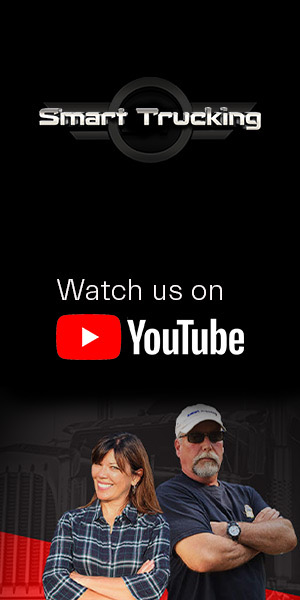
Everything You’ll Want To Know About Paid CDL Training
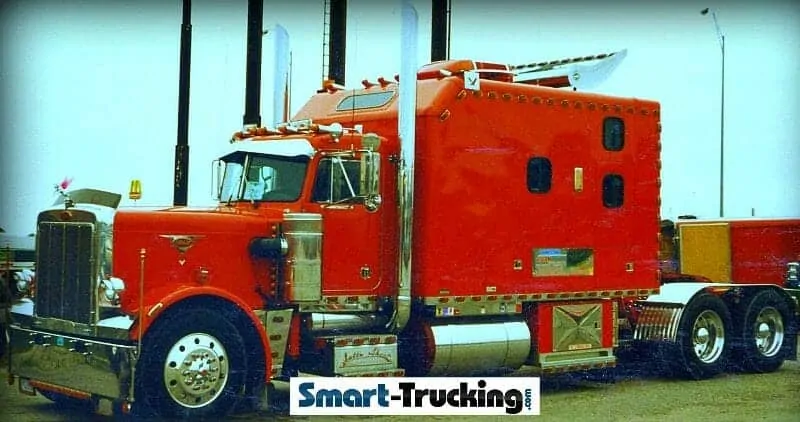
Custom Big Truck Sleepers Photo Gallery Collection
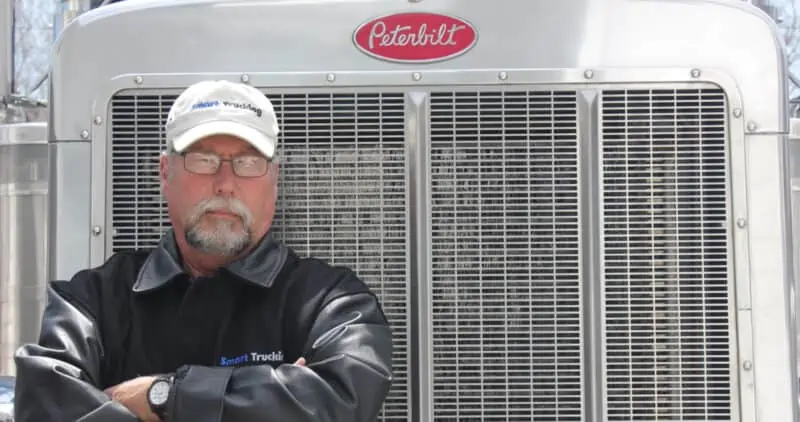
The Best Trucking Companies to Work For 2024 USA
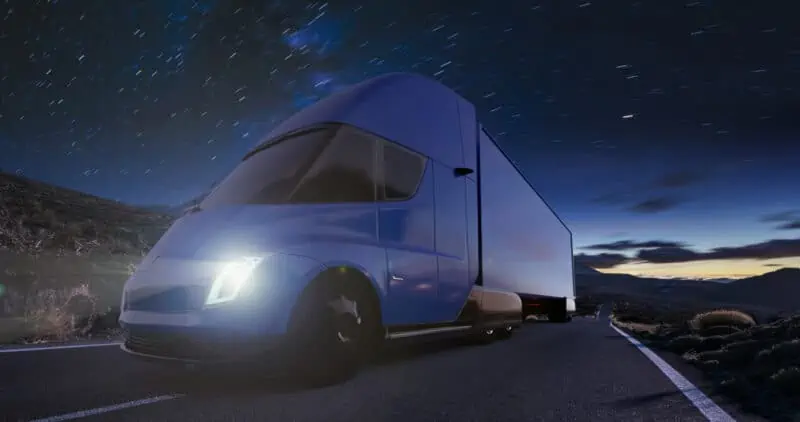
5 Best GPS For Truckers – A Professional Driver’s Guide
Twice a month we email you the best tips and new articles to help you better navigate the trucking industry..
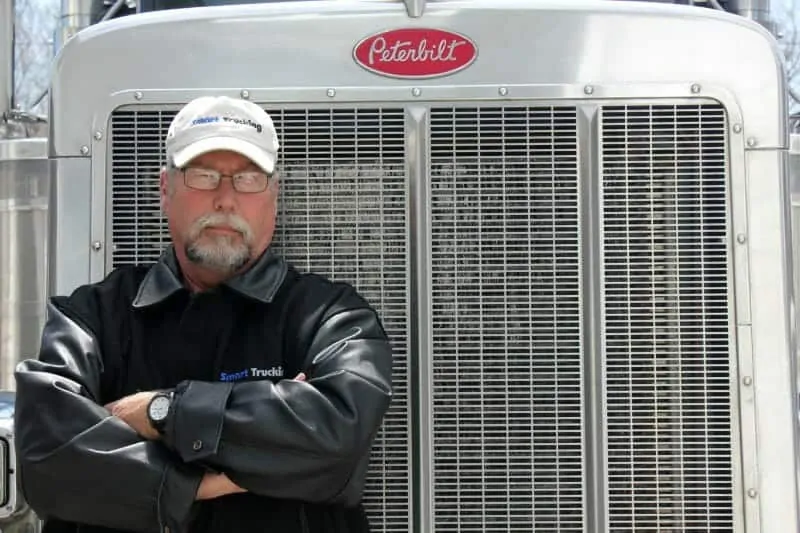
10 Truck Driving Safety Tips Every Professional Driver Should Follow
A veteran 40+ years truck driver shares 10 of the all time, tried and true truck driving safety tips ALL professional truckers should know AND follow! If every driver of EVERY vehicle on the road followed these safety tips, our roads would be SO much safer.
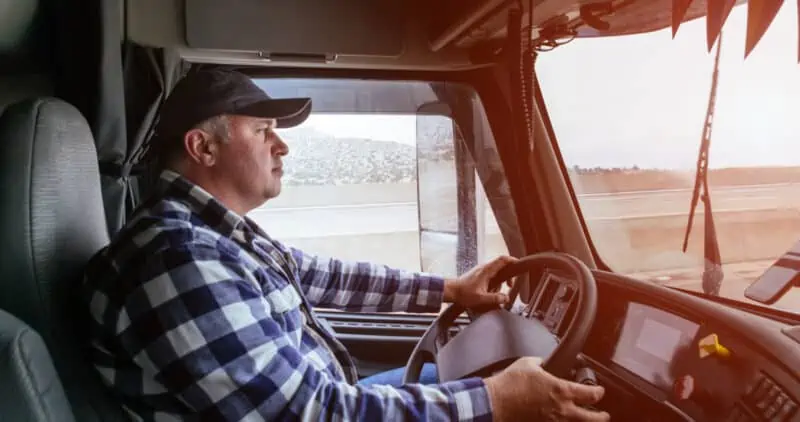
Trucker Tips Master Guide: Expert Advice From Experienced Truck Drivers
A collection of trucker tips from million milers and experienced drivers. These are gold nuggets for the new truck drivers!
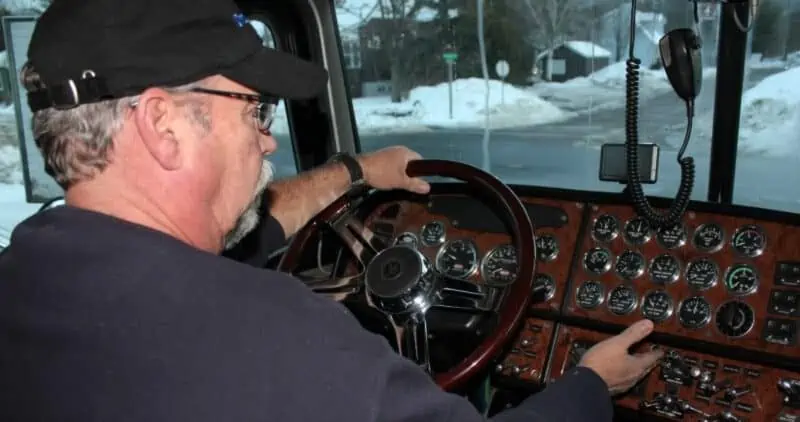
Instruction, clear advice, videos and photos for truck driver skills, maneuvers and information for all professional truck drivers.
A practical guide to paid CDL training programs. Recommended Company Sponsored Schools, Requirements, pros + cons, what to expect from company-sponsored cdl training programs.
Is a Career As a Department of Defense Truck Driver For You?
As a Department of Defense (D.O.D.) truck driver, your role is integral to the logistics and supply chain operations of […]
Navigating Fair Truck Driver Pay: Are You Earning Enough?
Ready to take control of your truck driver pay? Discover key factors impacting your earnings and ensure you’re compensated appropriately […]
The Best Tanker Trucking Companies to Work, U.S., 2024
Top Tanker Trucking Companies in the US To Work For Tanker work typically falls to the ‘better carriers’. Tanker carriers […]
Best Flatbed Trucking Companies, US, 2024: Our Top Picks
There are over 1 million truck drivers working for flatbed trucking companies in the U.S. trucking industry. However, not all […]
Best Trucking Companies For New Drivers in the U.S., 2024
For new drivers entering the trucking industry, diving into the right pool can make all the difference. The foundation of […]
Follow Smart Trucking
Pre- and Post-Trip Inspection Dos and Don’ts

Minimizing over-the-road breakdowns and preventing out-of-service violations are two of the many benefits of pre- and post-trip inspections. Use this list of dos and don'ts to complete your inspections the right way.
Don't: Think they're optional.
They're the law. Federal Motor Carrier Safety Administration (FMCSA) regulation 392.7 requires pre-trip inspections, while regulation 396.11 mandates post-trip inspections.
Do: Know what to check.
For a pre-trip inspection, check:
- parking brakes
- service brakes
- tires and rims
- steering system
- fluid levels
- belts and hoses
- electrical and air lines
- coupling devices
- air brake warning system
- emergency kit
- lights, reflectors and signals
- all applicable paperwork
Check the same items for post-trip inspections minus the fluid checks — don't touch anything that might be hot!

Don't: Kick-check the tires.
Thump checks don't work, because a tire sounds empty only if it's nearly 100% out of air. Use a calibrated tire gauge instead. Also, make sure all tires have the proper tread depth and that all lug nuts are tight.
Do: Double-check the brakes.
More than 1 out of every 4 vehicle out-of-service violations in the U.S. during the 2023 Commercial Vehicle Safety Alliance's (CVSA's) International Roadcheck were due to brake system violations.
Don't: Do an inspection differently each time.
Instead, develop a routine, and go in the same order with each pre- and post-trip check. Consider starting at the cab, then inside the cab, the front of the vehicle, then around the truck starting at the driver's side.
Do: Take your time.
There's no rush. Budget 10-15 minutes for a proper pre-trip inspection.
Don't: Forget the interior.
A clean cab tells an inspector that the rest of the vehicle is in good shape. A dirty cab says the opposite.
Do: Check your wheels.
It's the best way to make sure your truck doesn't accidentally move when you're doing a pre- or post-trip check. Forgetting to do so could cause a serious injury — or worse.
Do: Keep accurate logs.
Whether you use electronic or paper logs, keep them updated regularly, and make sure all other paperwork (driver's license, inspection, insurance) is current.
Don't: Ignore potential problems.
If you spot something out of the ordinary during your post-trip inspection, report it to dispatch immediately.
Download and share a PDF of this Safety Bulletin with your drivers.
English Español Français

At this time the Penske website requires that you enable JavaScript in order to take advantage of our website features. Please enable JavaScript and retry.
For assistance with other Penske services, please use the numbers below.
Truck Rental
- Household Rentals: 1-800-GO-PENSKE
- Business Rentals: 1-844-906-3404
Used Trucks
- 1-866-309-1962
Truck Leasing
- 1-888-234-4201
Penske Logistics
- 1-800-529-6531

- Register / Login
- Trucker's Forum
- Paid CDL Training
- Truck Driving Jobs
- CDL Practice Tests
- High Road Training
Pre-Trip Inspection Study Guide

Our Pre-Trip Inspection Study Guide has everything you need to prepare for the Class A CDL Pre-Trip Inspection Exam . Our study guide will cover the pre-trip inspection terminology as well as a thorough list of all of the parts you will be inspecting on the vehicle. For each part you will be inspecting there will also be a list of items you will be checking for. Our study guide is broken down into the following sections:
- What You Need to Know About Pre-Trip Inspection
Pre-Trip Inspection Practice Questions
- Pre-Trip Inspection Checklist
Pre-Trip Inspection Videos
Pre-trip inspection printable resources, what you need to know about the pre-trip inspection.
The Pre-Trip Inspection is a thorough inspection of the vehicle and all of its major systems. Inspecting the vehicle before driving each day is a Federal requirement and normally takes about 15 minutes. It must be logged in your logbook as "on duty not driving."
You will have to do thorough safety inspections of the coupling system, the vehicle lights, engine compartment, tires and brakes, the chassis, the fuel tanks, and an in-cab inspection.
The following information is a brief summary of Daniel's Complete Pre-Trip Inspection taken from our oustanding free PDF download:
Engine Compartment
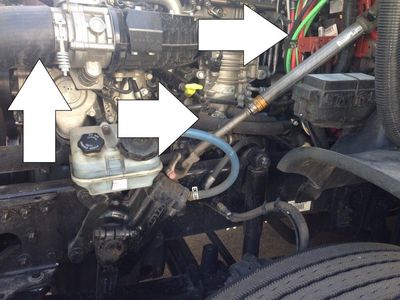
You will be checking the engine compartment for any sort of leaks. You will also be checking to see if all components are properly mounted and secured. None of the mounts must be cracked, bent, or broken.
You will be checking all hoses to make sure they aren't leaking, frayed, or sliced and the fluid levels including the oil level, the coolant, and the power steering fluid.
You must check the components like the water pump, the power steering pump, and the alternator to make sure nothing is leaking, the belts are not frayed, and that everything is properly mounted and secured.
From inside the engine compartment you will also find the steering system, the front suspension system, and the front brake system. All components of these systems must be properly mounted and secured without anything being cracked, bent, or broken. Finally you will be checking the tires, rims, and axle seals to make sure the tires are properly inflated, the rim isn't bent or cracked, and the axle seals are not leaking.
Fuel Tank And Battery Area

You will be standing along the side of the tractor doing a series of checks on the mirrors, fuel tanks, batteries, exhaust system, and more. You will check to make sure nothing is bent, cracked, broken, or leaking.
Check the mirrors, door hinges, door handle to make sure nothing is cracked, bent, or broken. Check to make sure there is no fuel leaking and that the fuel cap is secured and the gasket is not missing.
Check the exhaust system to make sure nothing is cracked, bent, or broken. Check the driveshaft, cat walk, and steps to make sure nothing is cracked, bent, or broken.
Check the frame and crossmembers for structural integrity. Check the air lines going to the trailer to make sure they're properly connected and that there are no abrasions, bulges, or cuts. Make sure the gaskets are present.
Check the suspension system and brakes on the drive axles, making sure nothing is cracked, bent, or broken. Make sure the brake linings are the proper thickness and that the air bags and properly inflated. Inspect the brake chambers, slack adjusters, and pushrods are properly mounted and secure. Not Cracked, Bent, or Broken. With the brakes released and pulled by hand, the Push Rod should not move more than 1 inch.
Check the rims, tires, and axle seals of the drive tires for proper inflation, no leaks around the seal, and the lugs are all present and secured.
Coupling System

You will be standing where the tractor and trailer are connected and you'll start by checking the electrical line and air lines to make sure they're properly mounted and secure at both ends. No abrasions, bulges or cuts. Not leaking air. Make sure the electrical line has no wires exposed. Check the gladhands to make sure the seals are in good condition, no cracks or signs of dry rotting. Not leaking air.
Check the skid plate of the fifth wheel and the apron of the trailer to make sure there is no debris and nothing is cracked, bent, or broken. Make sure the fifth wheel is properly greased. Also make sure there is no gap in between the fifth wheel and the trailer apron once the tractor and trailer are coupled. Make sure the kingpin of the trailer is properly mounted and not cracked, bent, or broken and that the locking jaws of the fifth wheel are properly secured when the tractor and trailer are coupled.
Check the mounting bolts where the fifth wheel attaches to the tractor frame. Make sure there are no missing bolts and that everything is secured properly. Check the locking pin if you having a sliding fifth wheel to make sure it's properly locked into place.
Make sure that there is the proper clearance space between the tractor mudflap and the trailer landing gear so that they don’t hit each other when making a turn.

You will start inspecting the trailer at the head board, which is the front wall of the trailer. Make sure there are no holes or missing rivets. Check the landing gear to make sure it is properly mounted and secure. Not cracked, bent, or broken. Make sure the fully raised and the handle is secure in the cradle when the tractor and trailer are coupled.
Check the frame and crossmembers under the trailer to make sure they're not cracked, bent, or broken. Check the tandem frame and release pins to make sure the frame is in good condition and the release handle and locking pins are in the fully locked position.
You will check the entire suspension and brake system for the trailer tandems the same way you did for the drive axles of the tractor. You will also make sure the mudflaps are properly secured. For dual tires check to see that there is proper space between the tires and there is nothing stuck between the tires.
Check the rear door and hinges to make sure they are properly mounted and nothing is cracked, bent, or broken. Make sure the door seals are not worn, torn, or dry rotted.
Light Check

You will be checking all of the lights and reflectors on both the tractor and the trailer. Check the reflectors and reflective tape to make sure they are properly mounted and secure, not cracked, bent, or broken, and clean and illuminated. Check that you have the proper color of amber to the front and sides, and red to the rear.
Start by turning on your marker lights and headlights. Now walk around the entire truck and trailer and point out the lights. Give the function of the light and the location. You should then ask your examiner to help you check your five functions.
While you're sitting in the drivers seat, the examiner will stand to the front of the truck, then behind the trailer. He will then check your Turn Signals, Four Way Flashers and Brake Lights. You must do each function at every location.
The five locations that you must check your lights:
- Front of the Truck
- Both sides of the Truck
- Rear of the Truck
- Both sides of the Trailer
- Rear of the Trailer
The Five Functions you are checking for:
- Left Turn Signal
- Right Turn Signal
- Four Way Flashers
- High Beams/Low Beams
- Brake Lights
In-Cab Inspection
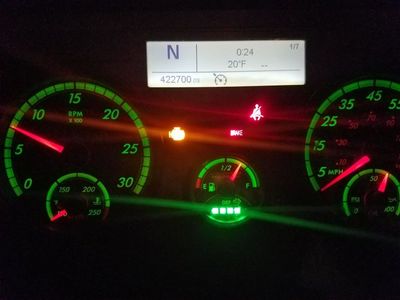
The in-cab inspection and air brake check will cover the various gauges and systems inside the cab along with several tests to make sure you air brake system is working properly.
You will start by checking the following:
- Seat Belt- Properly Mounted and Secure. Not ripped or frayed Adjusts and latches properly.
- Fire Extinguisher- Properly Mounted and Secure. Fully charged
- Three Red Reflective Triangles- My three red reflective triangles are GIVE LOCATION
- Spare Electrical Fuses- My spare electrical fuses are GIVE LOCATION
- Volmeter, Oil Pressure Gauge, Water Temperature Gauge, and Air Pressure Gauge all show proper operation
- City horn and air horn functioning properly
- The windshield and mirrors are clean, no cracks or breaks, no obstructions. The mirrors are in proper adjustment.
- Windshield Wipers and Washers - Demonstrate that the washers work by spraying the windshield. The Wipers are: Properly Mounted and Secure and operate smoothly. The blades aren't cracked or dry rotten.
- Heater and Defroster - Demonstrate that both the Heater and Defroster are working properly.
- Lighting Indicators - Left Turn, Right Turn, Four Way Flashers, and High Beams.
Trailer Parking Brakes - Set the Trailer Brake, release the tractor brake, and then tug lightly on the trailer.
Tractor Parking Brakes- Then set the Tractor Brake, release the trailer brake, and then tug lightly on the tractor.
Service Brake Check - Release both Tractor and Trailer Brakes. Now drive at idle speed. Apply the Service Brake to make sure you come to a complete stop, and that it doesn't pull to the left or right when applying the brakes.
Air Brake Test
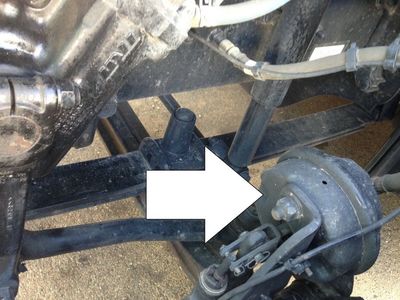
The air brake test will consist of a leakdown test to make sure your air brakes aren't leaking air and losing pressure. It will also test the warning lights and buzzer to make sure the driver gets the proper warning if the air pressure drops too low.
There are three stages to an Air Brake Test
#1: Applied Pressure Test
#2: Warning Light and Buzzer
#3 Tractor/Trailer Protection Valve Pop Out
Applied Pressure Test: Build the air pressure to governor cut out. Put the truck in the lowest gear. Then turn off the engine Immediately turn the engine back on. Push in both the tractor and trailer valves. (This will release the parking brakes.) Push and hold the Brake pedal fully. Allow the gauges to stabilize. Announce the gauges have stabilized and the Primary and Secondary PSI. With the Brakes fully pressed, you should not lose more than 4 PSI in one minute. Announce that you are listening for air leaks during that minute.
Warning Light and Buzzer Test: Pump down on the Brake pedal until the warning light and buzzer comes on, at or before 60 PSI.
Tractor/Trailer Protection Valve Pop Out Test: Pump down on the brake pedal until both the tractor and trailer protection valves pop out. They should both pop out between 40 and 20 PSI.
We have a ton of Pre-Trip Inspection Practice Questions along with the answers and a complete scoring system in our Free Online CDL Practice Tests :
The Engine Compartment Section will include questions about checking the oil level and coolant levels, inspecting belt-driven engine components (like the water pump, alternator, and air compressor), and the safety devices required in the cab. There will also be questions regarding the windshield wipers and free play in the steering wheel.
The Lights And Brakes Section will include questions about dashboard indicator lights, inspecting the parking brakes, and doing a leakdown test on the air brakes. It will also include questions about the low air pressure warning signal and testing your air horn and city horn.
The Suspension And Steering Section will include questions about the tractor protection valve, inspecting the steering box, and inspecting many suspension system parts. It will also include questions about welds being present on tire rims and the minimum tread depth required on steering axle tires.
The Tires And Coupling Devices Section will include questions about shiny trails or rusty threads on lug nuts, inspecting the battery box and cover, and inspecting electrical lines. It will also contain questions about inspecting the coupling devices and the fifth wheel skid plate.
The Emergency Equipment And Fifth Wheel Section will include questions about additional emergeny equipment required by school buses, inspecting the gap between the kingpin apron and the fifth wheel skid plate, and the landing gear securement. It will also contain questions about inspecting driver mirrors and the trailer frame.
Pre-Trip Inspection Checklist - Class A
Our pre-trip inspection checklist covers every part of the truck from front to back, both inside and outside of the truck. It covers the air brakes, suspension parts, steering components, wheels and rims, fuel tanks, batteries, lights, and more. It also covers the air brake tug test and checks for everything under the hood including alternator, water pump, fuel pump, fluids, and more.
This is a super handy checklist to study anytime you have a few minutes to spare:
Pre-Trip Inspection Checklist - Free Word Document Download (Editable Version)
Pre-Trip Inspection Checklist - Free PDF Download (Print Version)
Pre-Trip Inspection Video By Apex CDL Institute
Jeff from Apex Institute does an in-depth explanation of the entire pre-trip inspection process. This video is loaded with tips that go beyond the CDL test to help drivers really understand how to identify problems.
Pretrip Inspection Self-Test By CDL College
The Pretrip Inspection Self-Test By CDL College is really unique. It's a silent video which will show you the part you're inspecting and then gives you a few seconds to figure out what you should be checking for before giving you the answer. Definitely check this one out. Great for practicing before the CDL exam.
Pre-Trip Inspection Video By Averitt Express
This is a complete back to front pre-trip inspection of a truck and trailer by Averitt mainentance associate Kevin Breeding. This thorough pre-trip inspection covers all inportant points of inside the cab, lights, engine, the tractor itself and the trailer.
We have included two print versions of the pre-trip inspection process from Daniel. The first is the entire pre-trip inspection and the second is an abbreviated checklist for the inspection.
- PDF: Daniel's Pre-trip Inspection (Print Version)
- PDF: Daniel's Pre-trip Inspection Checklist (Print Version)

Why Join Trucking Truth?

- The High Road Training Program
- The High Road Article Series
- The Friendliest Trucker's Forum Ever!
- Email Updates When New Articles Are Posted
Apply For Paid CDL Training Through TruckingTruth
Did you know you can fill out one quick form here on TruckingTruth and apply to several companies at once for paid CDL training? Seriously! The application only takes one minute. You will speak with recruiters today. There is no obligation whatsoever. Learn more and apply here:
- Privacy Policy

The Federal Register
The daily journal of the united states government, request access.
Due to aggressive automated scraping of FederalRegister.gov and eCFR.gov, programmatic access to these sites is limited to access to our extensive developer APIs.
If you are human user receiving this message, we can add your IP address to a set of IPs that can access FederalRegister.gov & eCFR.gov; complete the CAPTCHA (bot test) below and click "Request Access". This process will be necessary for each IP address you wish to access the site from, requests are valid for approximately one quarter (three months) after which the process may need to be repeated.
An official website of the United States government.
If you want to request a wider IP range, first request access for your current IP, and then use the "Site Feedback" button found in the lower left-hand side to make the request.

Partnership
Sole proprietorship, limited partnership, compare businesses, employee rights, osha regulations, labor hours, personal & family, child custody & support, guardianship, incarceration, civil and misdemeanors, legal separation, real estate law, tax, licenses & permits, business licenses, wills & trusts, power of attorney, last will & testament, living trust, living will.
- Share Tweet Email Print
DOT Pretrip Inspection Regulations
By Roger Mock

- Dot Cargo Tank Testing Regulations

Trucks weighing tens of thousands of lbs. barrel along on highways at speeds of more than 50 mph. These massive transporters have equally massive destructive capabilities. As such, the Federal Motor Carrier Safety Administration of the U.S. Department of Transportation requires operators of commercial motor vehicles to perform a pretrip inspection to verify the integrity of all components and equipment. This inspection helps maintain safe operation.
According to Code of Federal Regulations (CFR) 392.7, a commercial motor vehicle may not be driven unless the following items have been verified as safe by a pretrip inspection: service brakes, hand brake, steering mechanism, all lighting devices, tires, horn, windshield wipers, rear view mirror and any coupling devices. Under CFR 392.8, drivers must check cargo or any securing devices within the first 50 miles of a trip to make sure no cargo shifts or falls from the vehicle.
Emergency Equipment
CFR 393.95 requires that all commercial motor vehicles feature emergency equipment, such as fire extinguishers and warning devices. One fire extinguisher with an Underwriter's Laboratories rating of 5 B:C or two fire extinguishers with a rating of 4 B:C are required. This extinguisher must be fully charged and properly labeled. In terms of warning devices, a commercial motor vehicle must have either three reflective triangles, three liquid burning flares or six fuses. The type of emergency equipment varies depending on the type of vehicle and cargo being transported. Flares, for example, would not be an ideal choice for a vehicle transporting a flammable substance. CFR 396.3 also states that push-out windows, emergency doors and door marking lights should be inspected every 90 days. Under CFR 392.8, checking and maintaining this equipment is considered part of the pretrip inspection. No vehicle may be driven without said equipment.
Inspection Report
CFR 396.13 requires a prevehicle inspection report before every operation. This verifies that the vehicle is in safe operating condition. The driver is also responsible for reviewing any previous inspection reports before operating. As the driver is required to sign the report, it is advised that the inspection be made properly, with any needed repairs being made before the trip.
Unsafe Operation
If a motor vehicle is not deemed safe to drive during a pretrip inspection, it must not be driven. According to CFR 396.7, it is illegal to drive a motor vehicle when it is likely to "cause an accident or a break down of the vehicle."
- Federal Motor Carrier Safety Administration: CFR 392
- Federal Motor Carrier Safety Administration: CFR 396
- Driver-Related FMCSA Regulations
Roger Mock began reporting in 2008 at the "B.G. News" in Bowling Green, Ohio. He has a Bachelor of Science in journalism from Bowling Green State University.
Related Articles
- An NYS Car Inspection Checklist
- OSHA Regulations on Theater Rigging
- DOT Regulations in Canada
49 CFR § 392.7 - Equipment, inspection and use.
(a) No commercial motor vehicle shall be driven unless the driver is satisfied that the following parts and accessories are in good working order, nor shall any driver fail to use or make use of such parts and accessories when and as needed:
(b) Drivers preparing to transport intermodal equipment must make an inspection of the following components, and must be satisfied they are in good working order before the equipment is operated over the road. Drivers who operate the equipment over the road shall be deemed to have confirmed the following components were in good working order when the driver accepted the equipment:
- THY Euroleague news
- BKT Eurocup News
- FIBA Europe Cup
- FIBA Intercontinental Cup
- ABA Adriatic
- BBL Germany
- HEBA Greece
- Legabasket Italy
- Pro A France
- Other Leagues
- Olympic Games
- FIBA World Cup
- Turkish Airlines Euroleague boxscores
- Turkish Airlines EuroLeague Standings
- Turkish Airlines EuroLeague Teams
- Alba Berlin
- Anadolu Efes
- Armani Milan
- Bayern Munich
- Crvena Zvezda
- Maccabi Tel Aviv
- Panathinaikos
- Real Madrid
- Žalgiris Kaunas
- Video gallery
- Eurohoops Dome
- Turkish Airlines Euroleague Gamecenter
- LATEST NEWS
- CSKA Moscow
- Zenit St Petersburg
- EN (English)
- Turkish Airlines Euroleague
Waiver of Certain Pre-trip Vehicle Inspection Skills Test Requirements for Certain School Bus Drivers (June 30, 2022)
Federal Motor Carrier Safety Administration
Waiver of Certain Pre-trip Vehicle Inspection Skills Test Requirements for Certain School Bus Drivers
June 30, 2022
AGENCY: Federal Motor Carrier Safety Administration (FMCSA), DOT.
ACTION: Grant of waiver.
SUMMARY: FMCSA permits, but does not require, States to waive the engine compartment component of the pre-trip vehicle inspection skills testing requirement in 49 CFR § 383.113(a)(1)(i), also known informally as the “under-the-hood” component, for commercial driver’s license (CDL) applicants seeking the school bus (S) and passenger (P) endorsements and the intrastate only (K) restriction. Drivers issued a CDL pursuant to this waiver are restricted to the intrastate operation of school buses only. Additionally, FMCSA waives the requirement in 49 CFR § 383.133(c)(1) that States administer this portion of the pre-trip vehicle inspection test in accordance with an FMCSA pre-approved examiner information manual. FMCSA issues this waiver in response to a request from the National School Transportation Association (NSTA) to address the ongoing shortage of school bus drivers.
DATES: This waiver is effective July 1, 2022, and expires on September 30, 2022.
FOR FURTHER INFORMATION CONTACT: Ms. Nikki McDavid, Chief of the Commercial Driver’s License Division, Office of Safety Programs, 202-366-0831, Federal Motor Carrier Safety Administration, 1200 New Jersey Avenue SE, Washington, DC 20590-0001.
Legal Basis
The Transportation Equity Act for the 21st Century (TEA-21) (Pub. L. 105-178, 112 Stat. 107, June 9, 1998) provides the Secretary of Transportation (the Secretary) authority to grant waivers from any of the Federal Motor Carrier Safety Regulations issued under Chapter 313 of Title 49 of the United States Code, or under 49 U.S.C. § 31136, to a person(s) seeking regulatory relief (49 U.S.C. §§ 31136(e), 31315(a)). The Secretary must make a determination that the waiver is in the public interest and that it is likely to achieve a level of safety that is equivalent to, or greater than, the level of safety that would be obtained in the absence of the waiver. Individual waivers may be granted for nonemergency and unique events for a period up to three months. TEA-21 authorizes the Secretary to grant waivers without requesting public comment, and without providing public notice.
The FMCSA Administrator has been delegated authority under 49 CFR 1.87(e) and (f) to carry out the functions vested in the Secretary by 49 U.S.C. chapter 313, relating to commercial motor vehicle operators, and 49 U.S.C. chapter 311, subchapter I and III, relating to commercial motor vehicle programs and safety regulations
On July 31, 2002, FMCSA published a final rule implementing section 214 of the Motor Carrier Safety Improvement Act of 1999, which required the Agency to create a new endorsement that CDL holders must obtain to operate a school bus (67 FR 49742). To implement this new endorsement, FMCSA added a definition of “school bus” to 49 CFR 383.5; amended other provisions of part 383 to recognize the new school bus endorsement; added a license code for the endorsement; and specified that applicants must pass both a knowledge and a skills test to obtain the endorsement. The rule established the minimum knowledge and skills test requirements for this new endorsement. The rule further established that an applicant for an S endorsement must qualify for the passenger vehicle endorsement (P) and pass the knowledge and skills tests for obtaining a P endorsement.
NSTA states that the school bus driver shortage remains an ongoing concern. NSTA notes that the most intensive school bus driver recruitments efforts occur during July through September, and requests a waiver through peak recruitment season. Industry representatives and States report that the engine compartment component of the CDL skills test has negatively impacted their ability to attract school bus driver applicants. Ensuring the safe and reliable transportation of children to and from school is FMCSA’s paramount concern. FMCSA issues this waiver in response to the unique but nonemergency circumstances resulting from the existing school bus driver shortage.
FMCSA’s Determination and Regulatory Provisions Waived
Consistent with the statutory requirements for waivers, FMCSA has determined that it is in the public interest to issue a waiver, until September 30, 2022, limited in scope and circumstances, that is likely to achieve a level of safety that is equivalent to, or greater than, the level of safety that would be obtained in the absence of the waiver. This waiver:
- Waives 49 CFR 383.113(a)(1)(i), which requires that CDL applicants must possess basic engine compartment pre-trip vehicle inspection skills for the vehicle class the driver operates or expects to operate. Subparagraph (i) requires applicants to identify each safety-related part of the engine compartment and explain what needs to be inspected to ensure a safe operating condition of each part. In accordance with the American Association of Motor Vehicle Administrators’ “2005 CDL Test System (July 2010 or newer Version) Model CDL Examiner's Manual” (AAMVA Test Model), which FMCSA has approved and provides to all State Driver Licensing Agencies (SDLAs), the engine compartment portion of the pre-trip vehicle inspection skills test includes: oil level; coolant level; power steering fluid/belt/gear; water pump belt/gear; alternator belt/gear; air compressor (belt/gear) or hydraulic master cylinder (as applicable); and leaks/hoses. Pursuant to the terms of this voluntary waiver, States may waive the engine compartment portion of the pre-trip vehicle inspection skills test only for applicants seeking a CDL with the S and P endorsements 1 and the intrastate only (K) restriction. States must continue to test these applicants on the remaining elements of the pre-trip vehicle inspection skills test, as discussed below.
- Waives 49 CFR 383.133(c), which requires that States administer and score the CDL skills test based solely on the standards contained in the FMCSA pre-approved examiner information manual that conforms to the AAMVA Test Model (49 CFR 383.131(b)). States availing themselves of the regulatory relief provided under this waiver are permitted to deviate from the standards set forth in the AAMVA Test Model, insofar as they require SDLAs to administer the engine compartment portion of the pre-trip vehicle inspection test for the applicants identified above.
FMCSA will not issue a finding or a determination of substantial noncompliance under 49 CFR part 384 against States for action or inaction consistent with this voluntary waiver.
Public Interest
FMCSA finds that granting this waiver, by helping to alleviate the school bus driver shortage, is in the public interest because school bus drivers play a vital part in assuring that children are transported safely to and from school and school activities. As discussed below, riding a school bus is recognized as the safest way to get to and from school. Further, to the extent that driver shortages have resulted in cancellation of in-person instruction days in some States, this waiver will serve the public interest by allowing more children to benefit from in-person rather than virtual classroom learning. FMCSA also recognizes that safely and reliably transporting school-aged children plays a critical role in contributing to the economy by allowing parents and caretakers to get back to work.
Safety Equivalency
Due to the limited scope of this waiver, the existing regulatory requirements that remain in place, and the terms, conditions, and restrictions set forth below, FMCSA has determined that the waiver is likely to achieve a level of safety that is equivalent to the level of safety that would be obtained absent the waiver. The waiver of a particular regulation should not be viewed in isolation but rather as part of the whole of all regulations governing the safety of drivers. Waiver determinations are made holistically, taking all relevant factors into account. See International Bhd of Teamsters v. DOT, 724 F.3d 206 (D.C. Cir. 2013).
FMCSA has determined that waiving the requirement that States conduct the engine compartment component of the pre-trip vehicle inspection skills testing requirement in 49 CFR § 383.113(a)(1)(i), and the requirement in 49 CFR § 383.133(c)(1) that States administer the engine compartment component of the pre-trip vehicle inspection test in accordance with the AAMVA Test Model for CDL applicants seeking the S and P endorsements with the Intrastate only K restriction, will not negatively impact safety.
States relying on this waiver must require CDL applicants taking the skills test in a school bus to perform the remaining elements of the pre-trip vehicle inspection components of the skills test, as currently set forth in 49 CFR 383.113(a)(1)(ii-ix): Cab/engine start, Steering, Suspension, Brakes, Wheels, Side of vehicle, Rear of vehicle and special features of Tractor-trailer, school bus, or coach/transit bus, if this type of vehicle is being used for the skills test. (emphasis added). Therefore, drivers obtaining CDLs under this waiver will have demonstrated their ability to safely operate the “special features” of a school bus. Further, because school buses are typically operated for relatively short distances (i.e., to and from school and school activities), 2 mechanics or other qualified personnel can readily provide roadside assistance in the event of an engine malfunction, and a replacement bus can be provided if necessary.
FMCSA notes that current Federal regulations do not require a school bus driver to make engine repairs or perform routine maintenance, even though the driver has successfully completed the engine compartment pre-trip inspection component of the CDL skills test. Rather, Congress has determined that the regulatory oversight of school bus operations is a State function, and most States have adopted vehicle maintenance and inspection standards that apply to school bus operations. 3 Any State or local school bus inspection and maintenance standards would continue to apply under this waiver.
Drivers issued a CDL pursuant to this waiver are authorized to engage solely in the intrastate operation of school buses, as defined in 49 CFR 383.5; the driver is not authorized to operate trucks, motorcoaches, or any other type of commercial motor vehicle. Accordingly, States issuing CDLs pursuant to this waiver must designate a “school bus only” restriction on the CDL in accordance with 49 CFR 383.153(a)(10)(ix), which permits States to add additional restrictions as long as the restriction is fully explained on the front or back of the CDL document. The school bus only restriction on the CDL will enable FMCSA personnel and State-based traffic enforcement officers to determine whether the driver is complying with this restriction. Employers will also be able to discern that the driver is restricted to the intrastate operation of school buses only.
In FMCSA’s judgment, this waiver, by helping to lessen the school bus driver shortage, will actually improve safety in an important respect. According to the National Highway Traffic Safety Administration (NHTSA), school buses are the most regulated vehicles on the road and are designed to be safer than passenger vehicles in preventing crashes and injuries. NHTSA estimates that students are 70 times more likely to arrive at school safely when traveling by bus than by passenger car. 4 More school bus drivers will mean more children are able to get to and from school by the safest means possible.
The SDLA must, upon request by FMCSA, provide the Agency with the names and CDL numbers of the drivers who were issued a CDL pursuant to the terms of this waiver, as authorized under current regulations. FMCSA intends to monitor the safety performance of these drivers to determine whether this waiver should be revised or revoked. The Terms, Conditions, and Restrictions as set forth below, taken collectively, provide the assurance needed to demonstrate that granting the waiver is likely to achieve an equivalent level of safety to, or greater than, the level of safety achieved in the absence of the waiver.
Unique Circumstances
As noted previously, there is a well-documented shortage of school bus drivers nationwide. FMCSA finds that the circumstances surrounding this waiver are unique because State and local governments are currently unable to meet the demand for school bus drivers.
For the reasons above, FMCSA grants a waiver of the regulatory requirements identified above, subject to the terms, conditions, and restrictions below.
Terms, Conditions, and Restrictions of the Waiver
This waiver covers States for the period beginning at 12:00 a.m. (ET) on July 1, 2022, and continuing through 11:59 p.m. on September 30, 2022. Under this waiver, a State may, but is not required to, waive the engine compartment portion of the pre-trip vehicle inspection skills test, set forth in 49 CFR 383.113(a)(1)(i), only for CDL applicants seeking the S and P endorsements, subject to the (K) restriction limiting their operation to intrastate commerce. States issuing CDLs pursuant to this waiver are waived from the requirement in 49 CFR § 383.133(c)(1) that this portion of the pre-trip vehicle inspection test be administered in accordance with an FMCSA pre-approved examiner information manual. FMCSA intends to continue to closely monitor the safety impacts of the relief granted under this waiver. As necessary, FMCSA may take action to modify the waiver, including scaling back the regulatory relief provided, or to terminate the waiver sooner, if conditions warrant.
States issuing CDLs pursuant to this waiver must abide by the following terms and conditions:
- The CDL credential must conform to the requirements of Part 383, subpart J.
- When issuing a K-restricted CDL with the S and P endorsements pursuant to this waiver, States must continue to comply with the applicable provisions set forth in 49 CFR 383.73.
- When issuing a K-restricted CDL with the S and P endorsements pursuant to this waiver, States must place a school bus only restriction on the CDL in accordance with 49 CFR 383.153(a)(10)(ix).
- States must conduct the remaining pre-trip vehicle inspection components of the skills test for drivers subject to this waiver, as set forth in 49 CFR 383.113(a)(1)(ii-ix).
- Upon request from FMCSA, the State must provide the names and CDL numbers of drivers who issued a CDL pursuant to the terms of this waiver, as authorized by 49 CFR 383.73(h) and 384.225(e)(2).
- This waiver applies only to the intrastate operation of school buses used to transport students from home to school, from school to home, or to and from school-sponsored events, as defined in 49 CFR 383.5. 5
- FMCSA reserves the right to revoke this waiver for drivers’ involvement in accidents, the failure of States or drivers to comply with the terms of this waiver, or as circumstances otherwise warrant.
__________________
Issued: June 30, 2022
Robin Hutcheson Deputy Administrator
1 49 CFR 383.123(a)(1) requires that applicants must pass the knowledge and skills test for the passenger endorsement in order to obtain the S endorsement.
2 In a recent study, “U.S. Active School Travel in 2017: Prevalence and Correlates” (Kontu, E., et al. Preventive Medicine Reports Vol. 17) (March 2020), the average distance to school was 6.9 miles. The abstract can be accessed at https://doi.org/10.1016/j.pmedr.2019.101024 .
3 See 69 FR 13803, 13804 (Mar. 24, 2004); 53 FR 18042-43 (May 19, 1988) (Describing State regulatory oversight of school bus operations).
4 NHTSA, School Bus Safety, https://www.nhtsa.gov/road-safety/school-bus-safety (last accessed Dec. 18, 2021).
5 49 CFR 383.5 defines “school bus” as “a CMV used to transport pre-primary, primary, or secondary school students from home to school, from school to home, or to and from school-sponsored events. School bus does not include operations of a for-hire motor carrier.”
- Moscow Tourism
- Moscow Hotels
- Moscow Bed and Breakfast
- Moscow Vacation Rentals
- Flights to Moscow
- Moscow Restaurants
- Things to Do in Moscow
- Moscow Travel Forum
- Moscow Photos
- All Moscow Hotels
- Moscow Hotel Deals
- Things to Do
- Restaurants
- Vacation Rentals
- Travel Stories
- Rental Cars
- Add a Place
- Travel Forum
- Travelers' Choice
- Help Center
Day trip to Suzdal/Vladimir without knowing Russian.. - Moscow Forum
- Europe
- Russia
- Central Russia
- Moscow
Day trip to Suzdal/Vladimir without knowing Russian..
- United States Forums
- Europe Forums
- Canada Forums
- Asia Forums
- Central America Forums
- Africa Forums
- Caribbean Forums
- Mexico Forums
- South Pacific Forums
- South America Forums
- Middle East Forums
- Honeymoons and Romance
- Business Travel
- Train Travel
- Traveling With Disabilities
- Tripadvisor Support
- Solo Travel
- Bargain Travel
- Timeshares / Vacation Rentals
- Central Russia forums
- Moscow forum

Hi TA colleagues,
Is it potentially going to make a huge difference on our trip (in terms of pleasantness-wise) if the two of us go to visit Suzdal and Vladimir (for a day or an overnight trip) without knowing any Russian?
The only reason we will need to pay for a tour is because of the language barrier. I'm more independent when it comes to travel (in safe places of course). I'm thinking of just hiring a taxi for the day.
Maybe I'm too optimistic?
(Never been to Russia before)

I would NOT hire a "taxi" for the day...what I would consider is getting yourself there by yourself by Express train (and back the next day), then hiring a local guide who would also provide the driving around...I did this even speaking Russian, and do not regret it one bit...your biggest "issue" then is where to stay overnight - for logistics, I ended up staying at the hotel Vladimir (about a 2 block walk - up a hill a bit) from the train station...but admittedly, Suzdal is more "rustic"...
Where would you find a local guide in Vladimir? Is it easy to do so? My impression is that arranging anything from Moscow is much more expensive.
The other fun thing about Vladimir is while a whole lot of folks in Russian from smaller cities all want to go to "the big city", I found the people there to be quite happy living where they were...their city indeed has a very rich, ancient history...
That's very helpful Ebertsj, thank you! I will try to contact Hotel Vladimir to find about local guide options.
Ebertsj, do you mind sharing the approximate cost for the guide/driver that you were quoted? We ended booking the same hotel because of the location. We plan to call the hotel in a few days once we are in Russia. Thanks a lot!
One option might be to just use a driver for Vladimir, and try to use public transport and do your own tour of Suzdal, but a bit trickier with no Russian as you would be using buses to get there and back...
We called the hotel. Although the receptionist wasn't quite helpful (maybe she just didn't know), she did say that taxis are available upon arrival. So that's good.
Thank you very much for the inputs again Ebertsj. They were very helpful!

PablosDad, I'd advise you to look for Vladimir official touristic site (there must be some) or a site of local tourist office/agency and try to find an English-speaking guide through them. On the whole I like Ebertsj' idea. Of course if you knew Russian you could come and see all sights by yourself, but as it is hiring a local guide is perhaps the best thing:)

We are wanting to do something similar.
I assume that at Hotel Vladimir they will store our luggage for us while we are in Suzdal?
Since we speak no Russian, would Hotel Vladimir staff help us agree on taxi fare with the driver for the trip to Suzdal?
When leaving Suzdal by taxi, is it good enough to just write down "Vladimir" in cyrillic for the driver, and have him/her write down for us what the fare would be?
Is there a hotel in Suzdal where we could organize a local English speaking tour/excursion from there, similar to what Hotel Vladimir does?
We just finished our trip there. Thanks to all the posts. It was a pleasant visit!
rfbeing2, yes you can store your luggages at Hotel Vladimir if you are going to visit Suzdal during the day. Or at the train station. The taxi cost between the two towns will depend on how you get the taxi. If you reserve a taxi in advance it will be about 1000 rubles, if you ask the hotel (or by yourself) to call at the time you leave (risk of no taxi available at the time), it will be cheaper. We paid less than 1000 going up to Suzdal. It's about 25 minutes of drive. I love these two historical towns, people were so friendly and genuine there, I doubt any kind of rip-offs would happen. But it's always good to ask before hand.
We didn't bother hiring an English speaking guide due to time and other constraints, although I have to admit that knowing Russia would make my understanding much better. But we reviewed the history after we got back to our hotel.
Hope you have a wonderful trip too!
- Train Booking Moscow to St. Peter Apr 24, 2024
- Planning trip to Russia Apr 09, 2024
- SIM card. Russian SIM cards, do they still work in the UK? Apr 09, 2024
- Union Pay debit card Mar 27, 2024
- Russian trying to book a hotel in Jerusalem Mar 14, 2024
- Dual Citizen Arrested in Russia Mar 12, 2024
- about clothes Feb 27, 2024
- NOTE - border crossing from Finland into Russia closed Feb 09, 2024
- Snow boots in Red Square Feb 04, 2024
- Travelling to Moscow & Murmansk with toddle in winter Feb 02, 2024
- Anyone traveling from London to Moscow this week ? Jan 27, 2024
- Booking accommodation Jan 11, 2024
- Traveling friends (Designers preferred) :) Jan 05, 2024
- Are shops and things closed during Christmas and New Week ? Dec 15, 2023
- Moscow to St Petersburg train or air?? 32 replies
- New Sapsan Express Train from Moscow to St Petersburg 18 replies
- New year's in moscow 8 replies
- Hop on Hop Off Bus Tour 5 replies
- How do you purchase Bolshoi Ballet tickets at a great price? 2 replies
- Select-a-room.com Are they legitimate? 3 replies
- Weather Moscow and St. petersburg in May 8 replies
- Night train to St Petersburg 3 replies
- ATM Access 12 replies
- Visa needed if on layover at Moscow Airport??????? 15 replies
Moscow Hotels and Places to Stay
- Where can I get initial answers to ANY question?

IMAGES
VIDEO
COMMENTS
(b) Pre-trip inspection. Before the beginning of any driveaway-towaway operation of motor vehicles in combination, the motor carrier shall make a careful inspection and test to ascertain that: ( 1 ) The tow-bar or saddle-mount connections are properly secured to the towed and towing vehicle;
Pre-trip Inspection (396.13) Before operating the vehicle, the driver must inspect the vehicle and be satisfied that it is in safe operating condition. If the last vehicle inspection report notes any deficiencies, the driver must review and sign to acknowledge and certify that the required repairs were made. Periodic Inspection (396.17, 396.21)
In the video above, find six inspection myths debunked in part of Overdrive 's Trucking Law video series . In this episode: 00:00 Intro to Trucking Law myths. 00:31 Myth 1:- Pre-trip inspection ...
A proper pre-trip inspection will include inspecting the brake system both in-cab and externally. Truck drivers should check the brake adjustment with the slack adjuster for proper alignment. Check brake linings for appropriate thickness. Ensure your truck's air lines aren't damaged, don't leak, and are properly sealed.
The Federal Motor Carrier Safety Administration's (FMCSA) waiver, effective January 3, 2022, permits States to waive the engine compartment component of the pre-trip vehicle inspection skills testing requirement in 49 CFR 383.113(a)(1)(i), known informally as the "under-the-hood" component, for commercial driver's license (CDL) applicants seeking the school bus (S) and passenger (P ...
DVIRs - Daily Vehicle Inspection Report. According to federal law (FMCSR Section 396.11), every day, a driver must submit a Daily Vehicle Inspection Report (DVIR) for each power unit he operates.Multiple trailers can go in one report. DVIRs are either paper or electronic. Not every trucking company (ahem) enforces this policy, so some truck drivers can go months or years without submitting a ...
Question 1: Must a driver prepare a written report of a pre-trip inspection performed under §392.7? Guidance: No. U.S. DEPARTMENT OF TRANSPORTATION. Federal Motor Carrier Safety Administration. 1200 NEW JERSEY AVENUE, SE. WASHINGTON, DC 20590. 1-800-832-5660. Subscribe to email updates. About. About FMCSA; Regulations; Safety;
Don't: Ignore potential problems. If you spot something out of the ordinary during your post-trip inspection, report it to dispatch immediately. Minimizing breakdowns and preventing violations are two of the many benefits of pre- and post-trip inspections. Use this list of dos and don'ts to complete your inspections the right way.
General - § 396.3 (a) Every motor carrier shall systematically inspect, repair, and maintain, or cause to be systematically inspected, repaired, and maintained, all motor vehicles subject to its control. Parts and accessories must be in safe and proper condition at all times. Pushout windows, emergency doors, and emergency door marking ...
Legal Focus. "Pre-Trip Inspections" - What Does the Law Require? In January 2022 the Federal Motor Carrier Safety Administration (FMCSA) granted a ninety day waiver of the "Under-the-Hood" portion of CDL skills test for school bus drivers to help address the driver shortage. Seven states implemented modified CDL testing for school bus ...
Our Pre-Trip Inspection Study Guide has everything you need to prepare for the Class A CDL Pre-Trip Inspection Exam. Our study guide will cover the pre-trip inspection terminology as well as a thorough list of all of the parts you will be inspecting on the vehicle. For each part you will be inspecting there will also be a list of items you will ...
Pre-trip inspecting your bulkhead. The next step in your pre-trip inspection is to check the front of your trailer, also known as the bulkhead. Wall - Check for any damage on the wall. Inspection Sticker - Check for a DOT inspection sticker. Make sure it's up to date to meet the DOT requirements for trailers.
eCFR :: 49 CFR 396.11 -- Driver vehicle inspection report (s). Title 49. Displaying title 49, up to date as of 4/23/2024. Title 49 was last amended 4/11/2024. The (CFR) is the official legal print publication containing the codification of the general and permanent rules published in the by the departments and agencies of the Federal Government.
This rule also harmonizes the pre- and post-trip inspection lists. It responds in part to the President's January 2011 Regulatory Review and Reform initiative, removing a significant information collection burden without adversely impacting safety. The Agency also makes a technical change to section 396.11 to eliminate redundant language.
Checkup. According to Code of Federal Regulations (CFR) 392.7, a commercial motor vehicle may not be driven unless the following items have been verified as safe by a pretrip inspection: service brakes, hand brake, steering mechanism, all lighting devices, tires, horn, windshield wipers, rear view mirror and any coupling devices.
(a) Equipment provided by motor carrier. (1) Report required. Every motor carrier shall require its drivers to report, and every driver shall prepare a report in writing at the completion of each day's work on each vehicle operated, except for intermodal equipment tendered by an intermodal equipment provider.The report shall cover at least the following parts and accessories:
(b) Drivers preparing to transport intermodal equipment must make an inspection of the following components, and must be satisfied they are in good working order before the equipment is operated over the road. Drivers who operate the equipment over the road shall be deemed to have confirmed the following components were in good working order when the driver accepted the equipment:
Khimki Moscow region started practices on Saturday for the upcoming year.
States issuing CDLs pursuant to this waiver are waived from the requirement in 49 CFR § 383.133(c)(1) that this portion of the pre-trip vehicle inspection test be administered in accordance with an FMCSA pre-approved examiner information manual. FMCSA intends to continue to closely monitor the safety impacts of the relief granted under this ...
Plan Your Trip to Lobnya: Best of Lobnya Tourism. Essential Lobnya. Do. Places to see, ways to wander, and signature experiences. See all. Temple of the Divine Savior. 26. Religious Sites. Temple-Chapel of St. Matrona. 11. Points of Interest & Landmarks. Lobnya Park of Culture and Recreation. 47. Parks.
Lobnya is a town in Moscow Oblast, Russia, located 30 kilometres north west of Moscow. Lobnya has about 84,200 residents. Mapcarta, the open map.
Answer 1 of 12: Hi TA colleagues, Is it potentially going to make a huge difference on our trip (in terms of pleasantness-wise) if the two of us go to visit Suzdal and Vladimir (for a day or an overnight trip) without knowing any Russian? The only reason we...